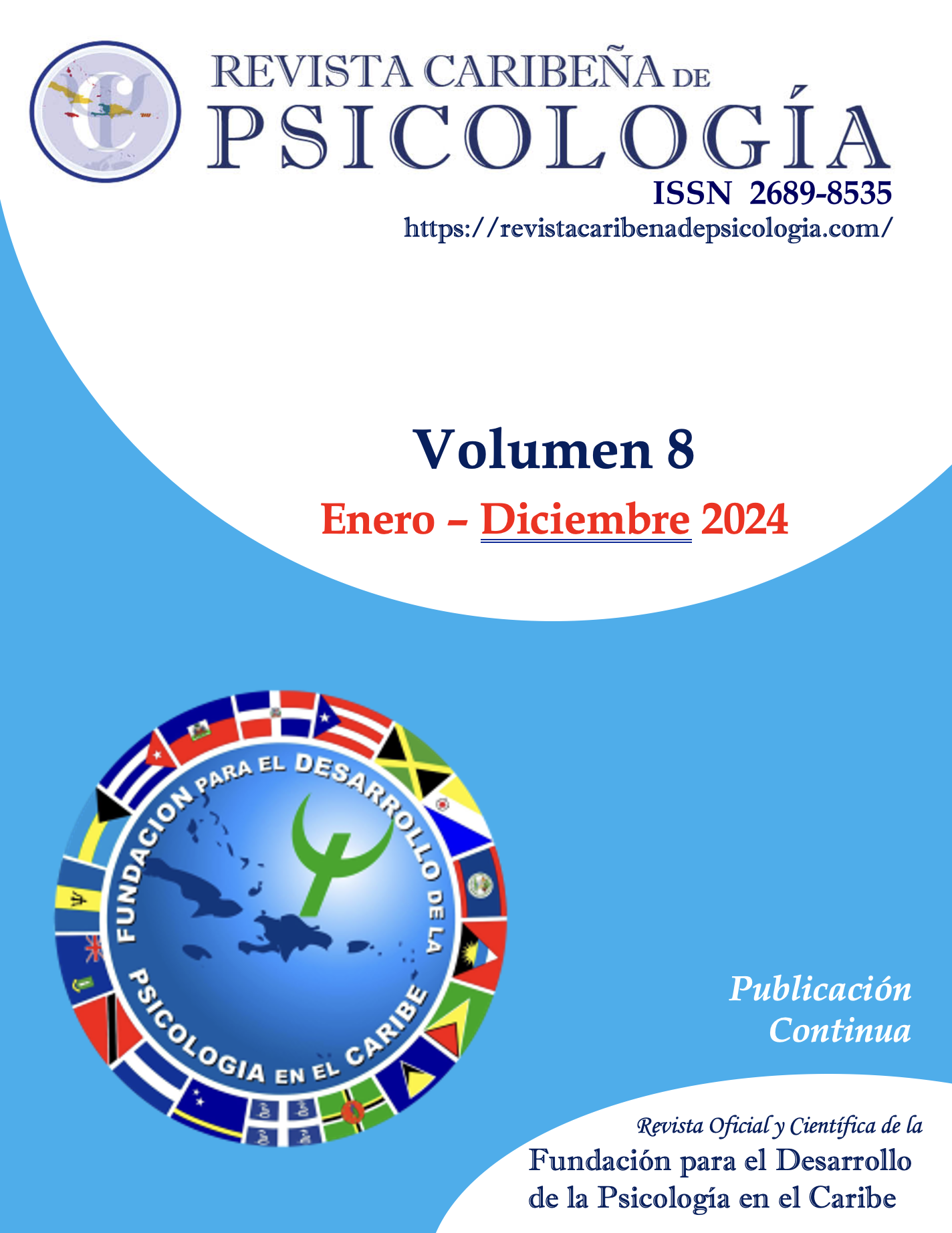Escala de Discrimen hacia los Tatuajes en el Contexto Laboral
DOI:
https://doi.org/10.37226/rcp.v8i1.7847Keywords:
behavior, body art, organizations, psychometrics, workAbstract
In today’s workplace, tattoos represent a challenge. However, the study of tattoos in the workplace has not yet been extensively carried out. Therefore, the construction of instruments with valid and reliable inferences to measure attitudes toward tattoos in the workplace has become crucial. The purpose of this study was to develop and analyze the psychometric properties of the Discrimination towards Tattoos Scale in the Workplace Context in a sample of 310 participants residing in Puerto Rico. To achieve this goal, various analyses related to construct validity, item analysis, and discriminant validity were conducted. The results show that the final version (M4) of the Attitudes towards Tattoos Scale in the Workplace Context with seven items and three dimensions: discrimination (α = .89), contempt ( = .89) and organizational perspective (α = .80) has adequate psychometric properties to be used in organizational studies and interventions in Puerto Rico.
References
Ágora. (s.f.). Tatuajes, lo que expresamos con nuestra piel. https://s3.amazonaws.com/academia.edu.documents/45325490/Tatuajes_2405.pdf?AWSAccessKeyId=AKIAIWOWYYGZ2Y53UL3A&Expires=1554235017&Signature=UepvU2T0I5bnWA3UiBR8izsNWa0%3D&responsecontentdisposition=inline%3B%20filename%3DTATUAJES_LO_QUE_EXPRESAMOS_CON_NUESTRA_P.pdf
Álvarez, N. (2000). El tatuaje: Guía didáctica del profesor. Red de Educación del Consumidor.
Carmen, R. A., Guitar, A. E., & Dillon, H. M. (2012). Ultimate answers to proximate questions: The evolutionary motiva-tions behind tattoos and body piercings in popular culture. Review of General Psychology, 16, 134-143.
Dars, A. (2014). Una imagen vale más que mil palabras: Arte cor-poral en el lugar de trabajo. Employee Responsibilities and Rights Journal, 27, 101-113. https://doi.org/10.1007/s10672-014-9254-1
Dodd, V. J., & White, K. M. (2015). Tattooed by stereotypes: How gender moderates the influence of tattoos on perceptions of job applicants. Basic and Applied Social Psychology, 37(6), 329-340.
Doornik, J. A., & Hansen, H. (2008). An omnibus test for univari-ate and multivariate normality. Oxford Bulletin of Economics and Statistics, 70, 927-939. https://doi.org/10.1111/j.1468-0084.2008.00537.x
Field, A. (2018). Discovering statistics using IBM SPSS statistics (5th ed.). SAGE Publications.
Fornell, C., & Larcker, D. F. (1981). Evaluating structural equation models with unobservable variables and measurement error. Journal of Marketing Research, 18(2), 39-50.
Francisco, M. E., & Ruhela, S. (2020). Correlational analysis of perception of tattoos and employability. International Confer-ence on Business Management, Innovation & Sustainability 2020. https://doi.org/10.2139/SSRN.3694377
Goffman, E. (1963). Stigma: Notes on the management of spoiled iden-tity. Simon and Schuster.
Hair, J., Black, W., Babin, B., & Anderson, R. (2010). Multivariate data analysis: A global perspective (7th ed.). Prentice Hall.
Hawkes, D., Senn, C., & Thorn, C. (2004). Factors that influence attitudes toward women with tattoos. Sex Roles, 50(1), 593-604. https://doi.org/10.1023/B:SERS.0000027564.83353.06.
Heilman, M. E., Block, C. J., & Martell, R. F. (2018). Sex stereo-types: Do they influence perceptions of managers? Journal of Social Issues, 74(4), 766-785.
Katz, D., & Stotland, E. (1959). A preliminary statement to a theo-ry of attitude structure and change. In S. Koch (Ed.), Psychol-ogy: A study of a science (Vol. 3). McGraw-Hill.
Kline, T. J. (2005). Psychological testing: A practical approach to de-sign and evaluation (1st. ed.). SAGE Publications, Inc.
María, L., & Resurrección, S. (2017). La discriminación y algunos de sus calificativos: Directa, indirecta, por indiferenciación, interseccional (o múltiple) y estructural. Pensamiento Constitucional, 22(1).
Martín-Baró, I. (1985). Acción e ideología: Psicología social desde Centroamérica. UCA Editores.
Miller, B., McGlashan, K. (2008). Body art in the workplace: Pierc-ing the prejudice. Personnel Review, 38(6), 621-640. https://doi/org/10.1108/00483480910992247
Monserrat, V. (2010). Sobre los artrópodos en el tatuaje. Boletín de la Sociedad Entomológica Aragonesa, 47, 477-497.
Montero, I., & Leon, O. G. (2007). A guide for naming research studies in psychology. International Journal of Clinical and Health Psychology, 7(3), 847–862.
Moreira, A. (2020). Historia del tatuaje. No Land Tattoo Parlour. https://www.nolandtattooparlour.com/historia-del-tatuaje-1/
Muñiz, M. (2019). Psicología del tatuaje. Facultad de Ciencias Hu-manas y Sociales de COMILLAS Universidad Pontificia.
Rupp, D. E., & Mallory, D. B. (2015). Corporate tattoos: HR's role in managing employee tattoos and corporate image. Business Horizons, 58(3), 337-345.
Sanz, M. (2021). The expression of identity through tattoos. Universi-dad Complutense de Madrid.
Satorra, A., & Bentler, P. M. (2001). A scaled difference chi-square test statistic for moment structure analysis. Psychometrika, 66, 507-514. https://doi.org/10.1007/BF02296192
Schumacker, R. E., & Lomax, R. G. (2010). A beginners guide to structural equation modeling. Routledge.
Swami, V. (2009). Body appreciation, media influence, and weight status predict consideration of cosmetic surgery among female undergraduates. Body Image, 6, 315-7.
Tajfel, H. (1974). Identidad social y comportamiento intergrupal. Información de Ciencias Sociales, 13(2), 65-93. https://doi.org/10.1177/053901847401300204
Timming, A. R. (2015). Visible tattoos in the service sector: A new challenge to recruitment and selection. Work, Employment and Society, 29(1), 60-78. https://doi.org/10.1177/0950017014528402
Timming, A. R. (2017). Effects of body art on perceptions of em-ployment suitability. Human Resource Management, 56(2), 333-352.
Wapa TV. (2020, febrero 18). No te puedes perder hoy el informe espe-cial “marcados por el tabú”. WapaTV [Video]. YouTube. https://www.youtube.com/watch?v=0MjqEBLxSH8
Wroblewski, S. (2017). El estigma contra los tatuajes en el lugar de trabajo: San Francisco versus el área de Kalamazoo. Universidad del Oeste de Michigan.
Downloads
Published
How to Cite
Issue
Section
License
Copyright (c) 2024 Yarí Marini Santiago, Ramón Rodríguez-Montalbán, Adam Rosario-Rodríguez

This work is licensed under a Creative Commons Attribution 4.0 International License.







